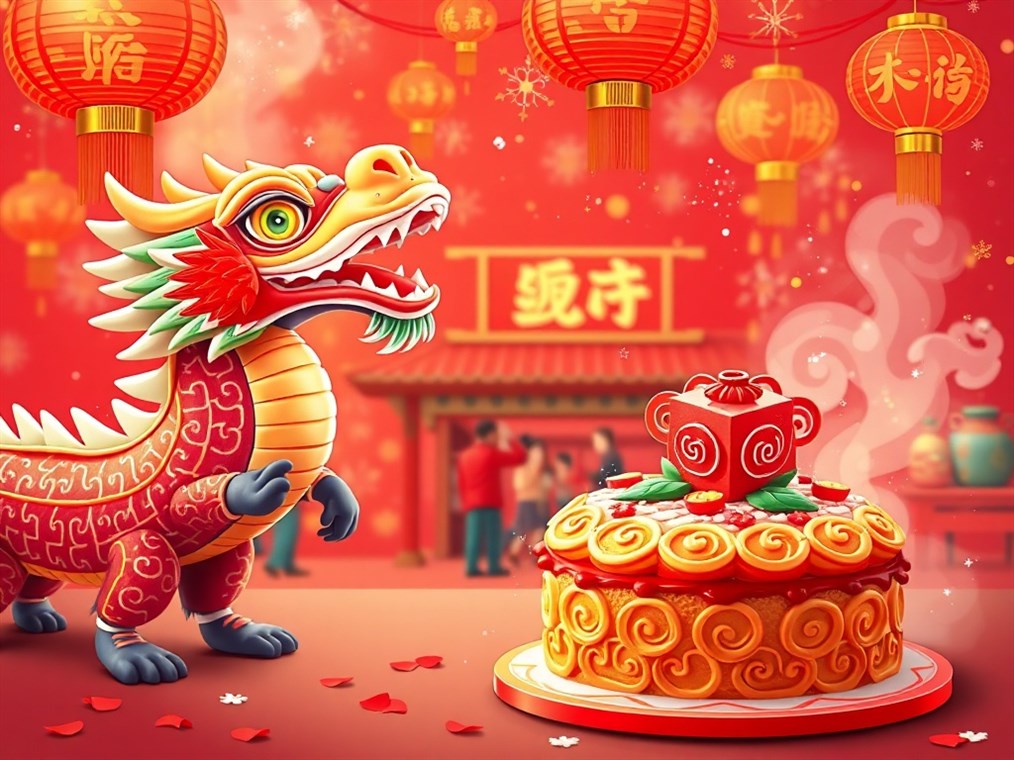Chinese New Year Cake: More Than Just a Sweet Treat
Chinese New Year! It’s a time for dragons, firecrackers, and, of course, incredible food. But have you ever stopped to wonder about that sticky, sweet cake you see everywhere? I’m talking about Nian Gao (年糕), or Chinese New Year Cake. It’s so much more than just a dessert; it’s a symbol of everything we hope for in the coming year.
So, where does this cake come from anyway? Nian Gao has roots stretching way back in Chinese history. The name itself is a bit of a clue. “Nian” (年) means year, and “Gao” (糕) means high or tall. Put them together, and you get something that sounds like “year high” (年高) – a wish for a better, higher year! Think of it as hoping for a raise, a promotion, or just plain better luck.
There are some pretty cool stories about how Nian Gao came to be. One involves a scary beast named Nian (yes, the same “Nian” as in New Year!). The villagers figured out that Nian hated loud noises and the color red, so they scared him off with firecrackers and red decorations. They also offered him Nian Gao, maybe as a peace offering, or perhaps just to keep him busy munching!
Then there’s the tale of Wu Zixu, a general from way back when. He apparently told his soldiers that if they ever got trapped, they should dig under the city wall for food. Turns out, the wall was built with glutinous rice flour bricks! Talk about a lucky find. Some say those bricks were the first Nian Gao, and we’ve been making it ever since to remember Wu Zixu’s cleverness. Or, there’s the legend about appeasing the Kitchen God, hoping the sticky cake would keep him from gossiping about your family to the Jade Emperor.
Okay, so what’s actually in this magical cake? The basics are pretty simple: glutinous rice flour (that’s what makes it so chewy!), water, and sugar. Brown sugar is a popular choice, giving it that lovely dark color. But that’s just the beginning. You can find Nian Gao with all sorts of goodies mixed in, like red dates, lotus leaves, or nuts. I’ve even seen some with wheat starch added for a softer texture, or kansui for a deeper color.
Making Nian Gao is a labor of love. It involves steaming the mixture until it becomes this wonderfully sticky, chewy cake. Many families have their own secret recipes passed down through generations. It’s usually made a day or two before the big celebration to give it time to set.
Now, here’s where it gets really interesting: Nian Gao isn’t just one thing. It changes depending on where you are in China!
- Up north, they like their Nian Gao white or yellow and sweet. Think jujubes and either glutinous or yellow rice.
- In Shanghai, it’s all about the white Nian Gao, made with non-glutinous rice. Stir-frying is the name of the game there.
- Down in Cantonese regions, you’ll find that dark yellow, stretchy, sticky Nian Gao made with brown sugar.
- Over in Fujian/Hokkien, they go all out with peanuts, red dates, melon seeds, walnuts – you name it! They might even fry it up after dipping it in egg or cornstarch.
- Shanxi and Inner Mongolia go for fillings like red bean or jujube paste.
- And in Hebei, you might find dates, small red beans, or green beans inside.
So, how do you actually eat this stuff? Well, one of the most popular ways is to slice it up and pan-fry it until it’s crispy on the outside and soft on the inside. Dipping it in egg batter and deep-frying it is another winner. Or, you can just steam it to soften it up. I’ve heard that in the Jiangnan region, they even put it in soup!
But before you dig in, remember that Nian Gao is more than just food. It’s good luck! Because its name sounds like “higher year,” eating it is like wishing for a promotion, a raise, or just a better year overall. Its round shape symbolizes family unity, and giving it as a gift is a way of wishing someone prosperity. It’s even offered to ancestors as a sign of respect. You’ll often see it decorated with carps (for surplus), ingots, or the God of Wealth.
And the Nian Gao love doesn’t stop in China! You can find similar rice cakes all over Asia. In the Philippines, they have tikoy, which comes from the Hokkien word for sweet cake. Burma has tikay, Cambodia has nom preahpout, Indonesia has kue keranjang or dodol Tionghoa, and Japan has mochi.
Even today, Nian Gao is a huge part of Chinese New Year. Sure, you can buy it pre-made, but many families still make it from scratch. And these days, you can even find Nian Gao dim sum or Nian Gao ice cream!
Thinking of trying your hand at making it? Here’s a super simple recipe:
Ingredients:
- 400g glutinous rice flour
- 300g dark brown sugar
- 2 cups water
Instructions:
- Dissolve the sugar in boiling water and let it cool.
- Slowly whisk in the rice flour until it’s smooth.
- Pour it into a greased cake pan.
- Steam for about an hour, or until it’s solid.
- Cool it, chill it, slice it, and then pan-fry or deep-fry it to warm it up.
So, as you celebrate Chinese New Year, remember Nian Gao. It’s a delicious, symbolic, and totally fascinating part of the holiday. Whether you make it yourself or buy it from the store, it’s a great way to welcome the new year with hope and good fortune!

